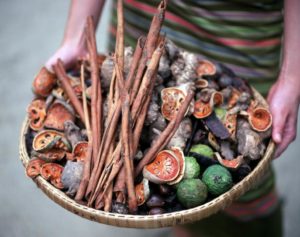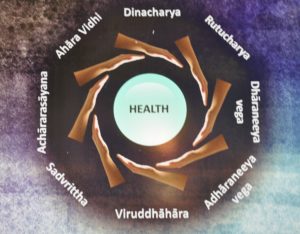The post Ayurveda and Panchakarma Benefits appeared first on MedDNA Blog.
]]>
There are immense ayurveda and panchakarma benefits. The word Ayurveda implies science of life. Ayur means life and veda means science. Ayurveda deals with medical science that was illustrated during ancient times. The science was established even before Christ era. Ayurveda pacts with Adharva Veda, it is about five thousand years old. The ancient people stated that the Vedic literature is pure, true clear and contains all mysterious advicesas well as guidelines to preserve and sustainfitness and how to combatsickness and various other infections and disorder via natural therapies, herbal medicines, diet control and exercise.
As per the researches of researchers the concept of Ayurveda was originated during prehistoric times and also prevalent at the time of Indus Valley Civilization. Ayurveda is based on 3 substances named as Dosha’s in Hindi. These Dosha includes Vata, Pitta and Kapha. When they are aligned, they result in good and Holy Spirit and when the alignment is disturbed then any form of illness may occur. Ayurveda is further divided into 8 components’ that are derivative of Sanskrit. The components include:
- Kāyacikitsā: general medicine for the body
- Kaumāra-bhṛtya: deals with the treatment of children, pediatrics
- Śalyatantra: deals with surgical procedures
- Śālākyatantra: deals with the treatment of ears, nose, mouth, etc.
- Bhūtavidyā: pacification of possessing spirits
- Agadatantra: comprises of toxicology
- Rasāyanatantra:consist of rejuvenation and tonics that helps in increasing lifespan, intellect and strength
- Vājīkaraṇatantra: deals with aphrodisiacs and treatments related to dysfunction of sex organs and infertility.
Principle:
Ayurveda always has explained to be in balance for everything, and one should not limit down its natural urge; as limiting natural urge may lead to illness. The ayurveda and panchakarma benefits are immense; it depends on the way we balance our life, the balance should be made in eating, sleeping, maintaining physical activities and also in sexual intercourse.
In Ayurveda there are seven basic tissues (dhatu). It comprises of
- plasma (rasa)
- blood (rakta)
- muscles (māmsa)
- fat (meda)
- bone (asthi)
- marrow(majja)
- semen (shukra).
As per Ayurveda our body is made up of five elements (panchabhuta). This Includes
And every person poses twenty gunas (qualities or characteristics) which helps in understanding the individual traits or personal traits. They all are organized in ten pairs of antonyms:
- heavy/light,
- cold/hot,
- unctuous/dry,
- dull/sharp,
- stable/mobile,
- soft/hard,
- non-slimy/slimy,
- smooth/coarse,
- minute/gross,
- viscous/liquid
The ayurvedic doctors use a simple holistic approach as Ayurveda illustrates that the fluid within the body flows via channels (srotas) and any blockage in the passage may lead to illness. The decrease in the flow can be opened up via massages of various oils and Swedana.
The doctor uses his all 5 senses to identify the disease of an individual. He can diagnose the sickness in 8 traditions. It consist of
- Nadi (pulse),
- Mootra (urine),
- Mala (stool),
- Jihva (tongue),
- Shabda (speech),
- Sparsha (touch),
- Druk (vision),
- Aakruti (appearance).
Treatment
Ayurveda involves two aspects dealing in surgery (Śalya-cikitsā and Śālākya-tantra). Though the actual existing Ayurveda inclines on reduction of stress andaccomplish in making the structure of a strong metabolic system..
Ayurveda and panchakarma benefits depends on the regular routine to be disciplined and systematic and very well balanced. Ayurveda also emphasis on hygiene, that comprises of regular bathing, cleaning of teeth, skin care, and eye washing. The treatment of Ayurveda is plant based that are the resultant of roots, leaves, fruits, bark, or seeds.
Panchakarma
As per the Ayurveda, panchakarma is the procedure to abolishes the toxic and poisonousorigins from the body. It consists of Vamana, Virechana, Basti, Nasya and Raktamokshanaand id monitored by Paschatkarma and Peyadikarma.
The Department of Ayurveda, Yoga and Naturopathy, Unani, Siddha and Homoeopathy (AYUSH), Ministry of Health and Family Welfare, talk about the Ayurveda and panchakarma benefits. In this center government cares and maintains all researches and preaching related to Ayurveda via every medium and handles it regionally, nationally and internationally and aids in institutionalize traditional medicine in every part of India.
There are many therapies included in it. These are enlisted below:
- Uzhilchil
- Abhyanga
- Pizhichil
- MarmaChikitsa
- Shirodhara
- Facial Marma
- MeruChikitsa
- Snehana / Snehapana
- Swedana (Sweat Therapy)
- Nasya
- Virechana
- PaadaAbhyanga (Foot Massage)
- PindaSweda
- Talapothichil (Shirolepa)
- Shirovasti
- Osteopathy
Ayurveda plays a vital role in making one’s lifestyle. It explains the importance of eating timely in right proportions, drinking clean and clear water, indulging in physical activities and sleeping sound and aptly. Ayurveda tells you the art of living and helps to manage the regulated changes necessary for well-balanced livelihood.
The post Ayurveda and Panchakarma Benefits appeared first on MedDNA Blog.
]]>